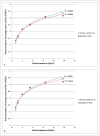Effect of Attenuated Light Through Translucent Zirconia on the Interfacial Adaptation and Polymerization of Resin Cements
- PMID: 37910068
- PMCID: PMC11734313
- DOI: 10.3290/j.jad.b4586857
Effect of Attenuated Light Through Translucent Zirconia on the Interfacial Adaptation and Polymerization of Resin Cements
Abstract
Purpose: The first objective was to determine if dual-curing of resin cement with reduced light could affect interfacial adaptations of zirconia restoration. The second objective was to examine whether cement type and pretreatment method of universal adhesive affected interfacial adaptation. The final objective was to compare the polymerization degree of cement under different reduced-light conditions.
Materials and methods: Inlay cavities were prepared on extracted third molars. Translucent zirconia restorations were milled using Katana UTML (Kuraray Noritake) in three groups with restoration thicknesses of 1, 2, and 3 mm, respectively. Each group had three subgroups using different cementation methods. For subgroup 1, restorations were cemented with self-adhesive cement. For subgroup 2, universal adhesive was applied and light cured. After the restoration was seated with conventional resin cement, light curing was performed. For subgroup 3, after adhesive was applied, the restoration was seated with conventional resin cement. Light curing was performed for the adhesive and cement simultaneously. After thermocycling, interfacial adaptation at the restoration-tooth interface was investigated using swept-source optical coherence tomography imaging. Finally, polymerization shrinkage of the cement was measured using a linometer and compared under the conditions of different zirconia thicknesses and light-curing durations.
Results: Interfacial adaptation varied signficantly depending on the zirconia thickness, pretreatment, polymerization mode and cements used (p < 0.05). The effects of the adhesive and polymerization shrinkage differed signficantly, depending on the reduced light under the zirconia (p < 0.05).
Conclusion: Lower curing-light irradiance may lead to inferior adaptation and lower polymerization of the cement. Polymerization of resin cement can differ depending on the light irradiance and exposure duration.
Keywords: exposure reciprocity; interfacial adaptation; polymerization shrinkage strain; radiant exposure window; resin cement; translucent zirconia.
Figures




Similar articles
-
Degree of conversion and interfacial adaptation of touch-cure resin cement polymerized by self-curing or dual-curing with reduced light.Clin Oral Investig. 2024 Aug 2;28(8):463. doi: 10.1007/s00784-024-05858-1. Clin Oral Investig. 2024. PMID: 39090476
-
Effects of Material Thickness and Pretreatment on the Interfacial Gap of Translucent Zirconia Restorations with Self-adhesive Resin Cement.Oper Dent. 2022 Sep 1;47(5):535-548. doi: 10.2341/21-024-L. Oper Dent. 2022. PMID: 36223319
-
Effect of Pretreatment and Activation Mode on the Interfacial Adaptation of Nanoceramic Resin Inlay and Self-adhesive Resin Cement.Dent Mater. 2020 Sep;36(9):1170-1182. doi: 10.1016/j.dental.2020.05.005. Epub 2020 Jun 11. Dent Mater. 2020. PMID: 32536587
-
The influence of zirconia veneer thickness on the degree of conversion of resin-matrix cements: an integrative review.Clin Oral Investig. 2021 Jun;25(6):3395-3408. doi: 10.1007/s00784-021-03904-w. Epub 2021 Mar 30. Clin Oral Investig. 2021. PMID: 33783593 Review.
-
A Scoping Review on the Polymerization of Resin-Matrix Cements Used in Restorative Dentistry.Materials (Basel). 2023 Feb 13;16(4):1560. doi: 10.3390/ma16041560. Materials (Basel). 2023. PMID: 36837188 Free PMC article.
Cited by
-
Degree of conversion and interfacial adaptation of touch-cure resin cement polymerized by self-curing or dual-curing with reduced light.Clin Oral Investig. 2024 Aug 2;28(8):463. doi: 10.1007/s00784-024-05858-1. Clin Oral Investig. 2024. PMID: 39090476
References
-
- Aguiar TR, Di Francescantonio M, Arrais CA, Ambrosano GM, Davanzo C, Giannini M. Influence of curing mode and time on degree of conversion of one conventional and two self-adhesive resin cements. Oper Dent. 2010;35:295–299. - PubMed
-
- Aldhafyan M, Silikas N, Watts DC. Influence of curing modes on conversion and shrinkage of dual-cure resin-cements. Dent Mater. 2022;38:194–203. - PubMed
-
- Aljabo A, Xia W, Liaqat S, Khan MA, Knowles JC, Ashley P, Young AM. Conversion, shrinkage, water sorption, flexural strength and modulus of re-mineralizing dental composites. Dent Mater. 2015;31:1279–1289. - PubMed
-
- Amirouche-Korichi A, Mouzali M, Watts DC. Effects of monomer ratios and highly radiopaque fillers on degree of conversion and shrinkage-strain of dental resin composites. Dent Mater. 2009;25:1411–1418. - PubMed
-
- Asmussen E, Peutzfeldt A. Influence of pulse-delay curing on softening of polymer structures. J Dent Res. 2001;80:1570–1573. - PubMed
MeSH terms
Substances
LinkOut - more resources
Full Text Sources

